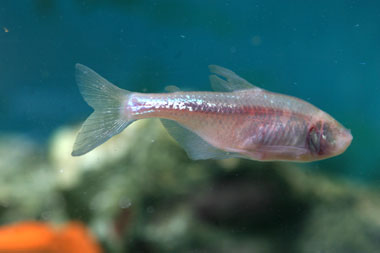Blind Cave Fish
Scientific Name: Astyanax fasciatus
Mon, 28th April, 2025 - 9:45 am GMT
Sponsor Ads:

Alternative Name
Scientific Name: Astyanax fasciatusBasic Info
At maturity, the Blind Cave Fish reaches an average between just under 7 centimeters to 9 centimeters. There seems to be some debate as to what is actually the average length of this fish. They have an eerie translucent body, which has a bright yellow tint. The female Blind Cave Fish is bigger than the male. An interesting physical feature of the Blind Cave Fish is its lack of eyes, from which it gets its name. When they are born, they have eyes. But as the fry grow, their eyes fall out, leaving them blind.
Health
The Blind Cave Fish is an easy fish to care for. They do not really need anything specific to survive, and are generally quite hardy. They should be kept in tanks with water temperatures ranging between 68 and 77 degrees Fahrenheit. The pH of their water should be slightly acidic, with a range between 6.2 and 7.0. They should be fed the normal fish foods, including brine shrimp, glass worms, bloodworms, tubifex worms and flake foods. They are also reported to enjoy glass shrimp as well. Breeding The Blind Cave Fish is relatively easy to breed. Keeping them in water with a colder temperature, around 68 degrees, helps to stimulate breeding. When spawning, the female will lay roughly 70 eggs.Habitat
Fresh water fish - The Blind Cave Fish is found where there is no light, in deep caves off the coast of Mexico.Behavior
The Blind Cave Fish is an excellent fish for beginning aquarists and community tanks. Due to their bright exotic appearance and small size, they make great additions to any aquarium. The Blind Cave Fish is a peaceful fish, and will not bother its tankmates. They are best kept in schools of three or more. Blind Cave Fish are very sensitive to vibrations. They use vibrations to navigate and find food. Blind Cave Fish should be kept in aquariums with moderate rock and plant decoration. The Blind Cave Fish will not bother live plants. The average lifespan of the Blind Cave Fish is between 5 and 7 years, though some will live over 10 years.Origin
Central AmericaHistory
Recently, they have been in the spotlight for their acceptance of transplanted eyes. Lenses from a surface-dwelling fish were implanted into the Blind Cave Fish. After eight days, lenses began to develop on the Blind Cave Fish, and rods developed. This has given insight into the development of the eye, and has given hope for human eye transplants.Common Foods
N/ASponsor Ads:
Few people think more than two or three times a year; I have made an international reputation for myself by thinking once or twice a week. --George Bernard Shaw
Blind Cave Fish
Coded by: BGID® | ALL RIGHTS RESERVED Copyright © 2000-2025
Disclaimer | Privacy | Report Errors / Contact | Credits
















